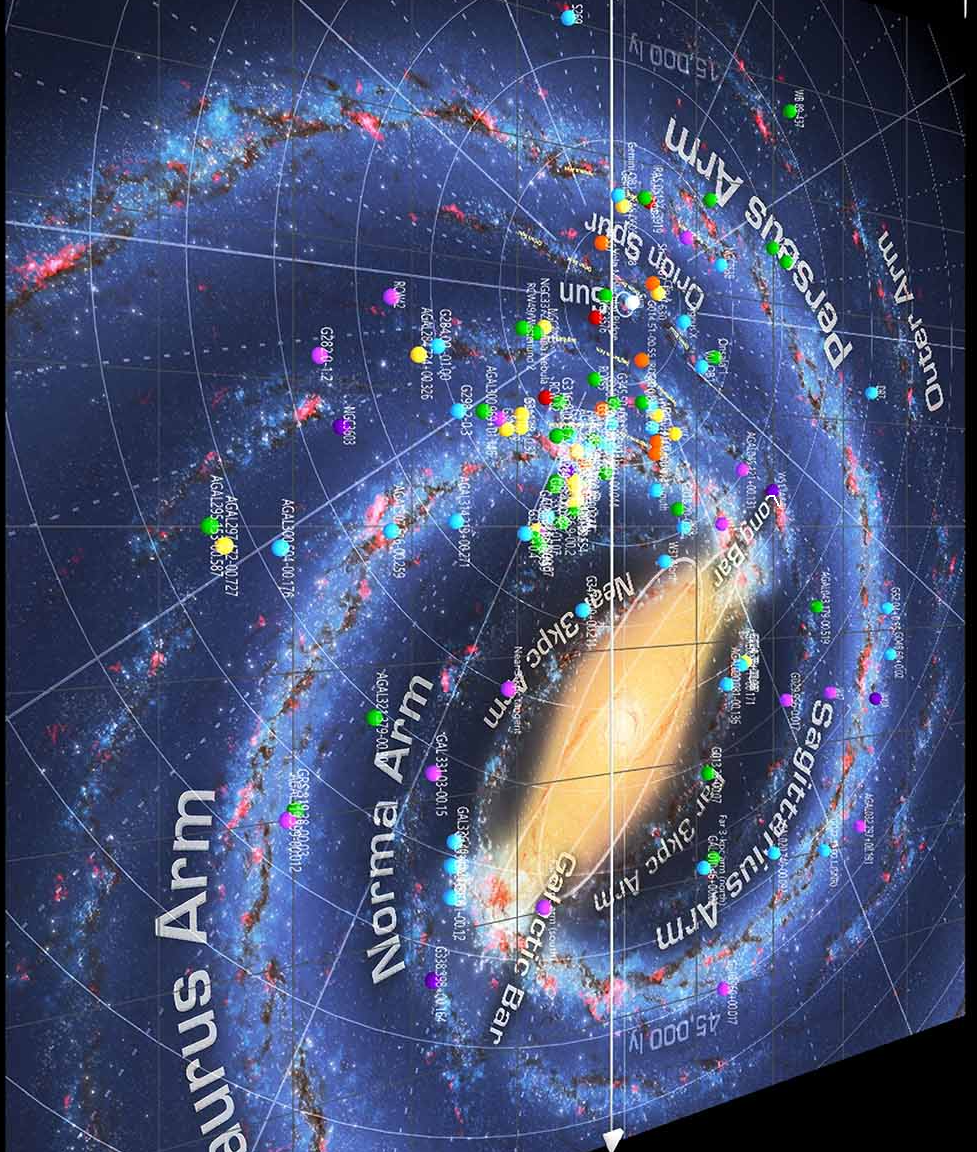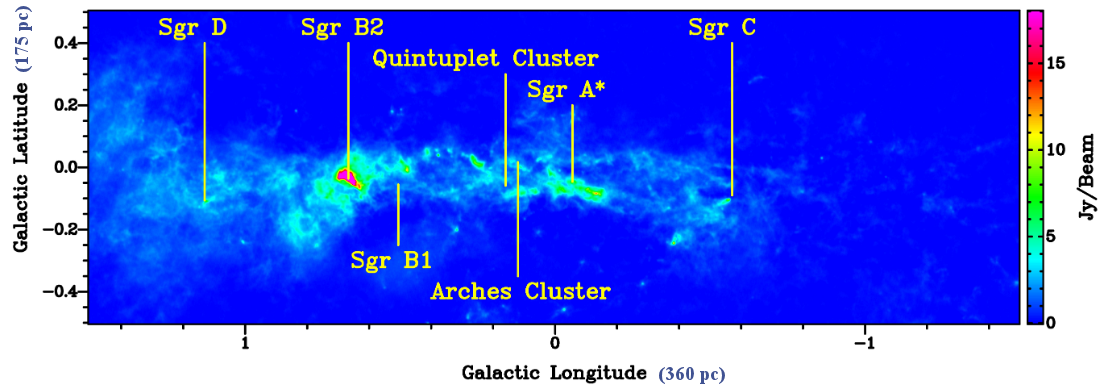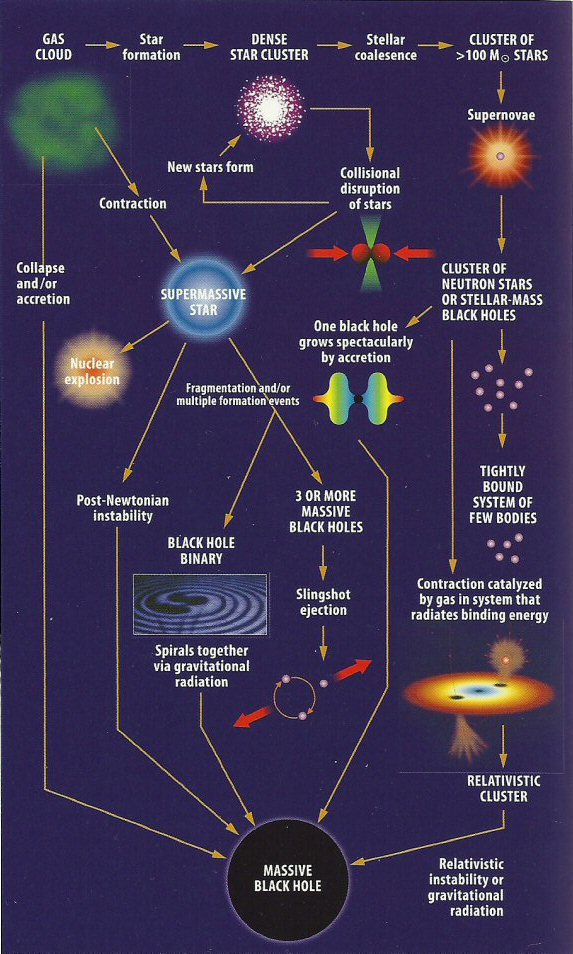
The Far 3-kpc arm was discovered in 2008. It has properties like radius, expansion velocity, mass, and brightness that were mirror images of the near 3-kpc arm.
| Home Page | Overview | Site Map | Index | Appendix | Illustration | About | Contact | Update | FAQ |
 |
The Near 3-kpc Arm was discovered in the 1950's through 21-centimeter radio measurements of HI (atomic hydrogen). It was found to be expanding away from the center of the Milky Way at more than 50 km/s contrary to the notion of everything falling into the black hole at the Milky Way center. A very simple explanation is by Newton's 3rd law of action/reaction, and it also occurs in 2 opposite directions to conserve linear momentum. This spiral arm contains about 10 million solar masses of gas, mostly hydrogen atoms and molecules. It is about 3.3 kpc from the galactic center and 5.2 kpc from the Sun. The Far 3-kpc arm was discovered in 2008. It has properties like radius, expansion velocity, mass, and brightness that were mirror images of the near 3-kpc arm. |
Figure 05-16f4 3-kpc Arms [view large image] |
Figure 05-16f4 is a two dimansional H1 density map near the Milky Way center with longitude of the Galactic coordinates imposed on top. |
 |
|
Figure 05-16f5 Milky Way, Inner Region [view large image] |
 |
These observations suggest different kinds of model to explain the origin of 3-kpc arms. Ultimately, they are related to the activities in the Galactic Center (GC). In barred spirals, there is a bar of stars runs through the central bulge. The arms of barred spirals usually start at the end of the bar. It is suggested that galactic bars develop when stellar orbits in a spiral galaxy become unstable and deviate from a circular path. The tiny elongations in the stars' orbits grow and get locked into place, forming a bar. The bar becomes even more pronounced as it collects more and more stars in elliptical orbits. Eventually, a high fraction of the stars in the galaxy's inner region join the bar. This process is said to be demonstrated repeatedly with computer-based simulations. |
Figure 05-16f6 MW Bars |
Figure 05-16f6 shows the structure of the inner Milky Way including : the bulge, the long bar (origins of the spiral arms at its ends), an additional galactic bar, and the "3-kpc arms" - the near one is inside the Norman arm, both 3-kpc arms are devoid of stars.  |
 |

|
Figure 05-16f7 Instability |
In another word, instability will develop with either or both high averaged stellar random velocity and low stellar surface density. See "Firehose Instability". |
 |
GC has been observed back in late 1990 (see "Galactic Center Molecular Arms, ..."). There is also indication of young star forming at the outer edge of the Milky Way. Expansion rate of 500 m/sec has been measured for the galaxy NGC4565 (see "Are the Milky Way’s borders expanding?"). It seems that expansion is a feature for certain galaxies including the Milky Way contrary to the notion of everything tends to fall into the central black hole. |
Figure 05-16f8 CMZ |
Figure 05-16f8 is a velocity-declination map showing the 3-kpc arm and the Central Molecular Zone (CMZ) which is confined to a region of about 150 pc (1 pc ~ 10 times the size of the solar system out to the Oort cloud). |
 |
 |
surrounded by a very dense star cluster, two other adjacent star clusters, and a giant molecular cloud which would serve as an incubator to a new generation of stars. The gas and dust in its vicinity are denser by 2-3 orders of magnitude than in other locations in the Milky Way. This is also the case with the magnetic field. The kinematics of the gas is characterized by apparently random, supersonic flows. The paper on "Shock-Generated Turbulence In the Innermost 50 pc of the Galaxy Center" provides observational evidence for the existence of a supersonic turbulence, most likely generated by the shock waves. |
Figure 05-16f9 MW Center [view large image] |
Figure 05-16f10 GC |
Figure 05-16f9 shows the 21 cm radio wave observation with a few identified objects (the insert is in 6 cm radio); Figure 05-16f10 is an artist's rendition for a lot more possible objects and expolsive processes around the black hole (see more in "Black Hole at the Milky Way Center"). |